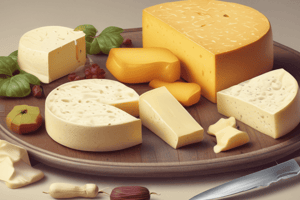Podcast
Questions and Answers
Which type of cheese is characterized by a creamy texture and is often spreadable?
Which type of cheese is characterized by a creamy texture and is often spreadable?
- Hard Cheese
- Soft Cheese (correct)
- Fresh Cheese
- Semi-Hard Cheese
What is the primary purpose of rennet in cheese production?
What is the primary purpose of rennet in cheese production?
- To enhance texture
- To flavor the cheese
- To pasteurize the milk
- To curdle the milk (correct)
Which type of cheese is known for having blue veins of mold?
Which type of cheese is known for having blue veins of mold?
- Blue Cheese (correct)
- Soft Cheese
- Processed Cheese
- Fresh Cheese
What is a common health consideration regarding cheese consumption?
What is a common health consideration regarding cheese consumption?
What is the significance of aging in cheese production?
What is the significance of aging in cheese production?
Which storage method is recommended for prolonging the shelf life of cheese?
Which storage method is recommended for prolonging the shelf life of cheese?
What type of cheese is typically aged for a longer period and has a dry texture?
What type of cheese is typically aged for a longer period and has a dry texture?
What is a common culinary use for cheese?
What is a common culinary use for cheese?
Flashcards are hidden until you start studying
Study Notes
Overview of Cheese
- Cheese is a dairy product derived from milk, produced through the coagulation of milk proteins.
- Commonly made from the milk of cows, goats, sheep, and buffalo.
Types of Cheese
-
Fresh Cheese:
- Unaged and has a mild flavor (e.g., ricotta, mozzarella).
-
Soft Cheese:
- Creamy texture; can be spreadable (e.g., Brie, Camembert).
-
Semi-Hard Cheese:
- Firmer texture, aged for a few weeks to months (e.g., Cheddar, Gouda).
-
Hard Cheese:
- Aged for a longer period, with a dry texture (e.g., Parmesan, Pecorino).
-
Blue Cheese:
- Characterized by blue veins of mold (e.g., Roquefort, Gorgonzola).
-
Processed Cheese:
- Made from natural cheese, combined with emulsifiers. Often used in slices or spreads.
Ingredients and Production
-
Key Ingredients:
- Milk, cultures, rennet (an enzyme for curdling), and salt.
-
Production Steps:
- Milk Preparation: Pasteurized to eliminate harmful bacteria.
- Curdling: Rennet and bacterial cultures added to form curds.
- Cutting Curds: Curds are cut to release whey.
- Cooking and Washing: Curds may be heated or washed to change texture.
- Draining Whey: Separation of curds from whey.
- Forming: Curds shaped into molds.
- Aging: Controlled conditions to develop flavor and texture.
Nutritional Profile
- Rich in protein, calcium, phosphorus, and vitamins.
- High in fat; choose low-fat options for healthier choices.
- Probiotics present in certain cheeses can enhance gut health.
Uses of Cheese
- Culinary ingredient in a variety of dishes (pizzas, salads, sandwiches).
- Served as snacks, accompaniments (cheese boards), or in desserts.
- Pairing with wines to enhance flavors.
Cheese in Different Cultures
- Varieties and consumption patterns reflect cultural preferences.
- Cheeses like feta in Greek cuisine, paneer in Indian cooking, and cheddar in British cuisine highlight diversity.
Storage and Preservation
- Cheese should be stored in refrigeration to prolong shelf life.
- Wrap in cheese paper or wax paper for best preservation.
- Mold may be trimmed off some cheeses, while others should be discarded entirely.
Health Considerations
- Lactose intolerance and allergic reactions are common concerns.
- Moderation is key due to high-fat content and sodium in many cheese varieties.
Overview of Cheese
- Cheese is a dairy product made by coagulating milk proteins.
- Commonly produced from cow, goat, sheep, and buffalo milk.
Types of Cheese
- Fresh Cheese: Unaged, mild flavor (e.g., ricotta, mozzarella).
- Soft Cheese: Creamy, spreadable (e.g., Brie, Camembert).
- Semi-Hard Cheese: Firmer texture, aged for weeks to months (e.g., Cheddar, Gouda).
- Hard Cheese: Aged for a longer period, dry texture (e.g., Parmesan, Pecorino).
- Blue Cheese: Characterized by blue mold veins (e.g., Roquefort, Gorgonzola).
- Processed Cheese: Made from natural cheese, blended with emulsifiers, often in slices or spreads.
Ingredients and Production
- Key Ingredients: Milk, cultures, rennet (curdling enzyme), salt.
- Production Steps:
- Milk Preparation: Pasteurized to kill bacteria.
- Curdling: Rennet and cultures added to form curds.
- Cutting Curds: Curds are cut to release whey.
- Cooking and Washing: Curds may be heated or washed for texture changes.
- Draining Whey: Separating curds from whey.
- Forming: Curds shaped into molds.
- Aging: Controlled conditions for flavor and texture development.
Nutritional Profile
- High in protein, calcium, phosphorus, and vitamins.
- High fat content, low-fat options are healthier.
- Some cheeses contain probiotics, beneficial for gut health.
Uses of Cheese
- Culinary ingredient in dishes (pizzas, salads, sandwiches).
- Served as snacks, accompaniments (cheese boards), or desserts.
- Cheese pairings with wines enhance flavors.
Cheese in Different Cultures
- Cheese varieties and consumption reflects cultural preferences.
- Examples: feta in Greek cuisine, paneer in Indian cooking, cheddar in British cuisine.
Storage and Preservation
- Refrigerate for extended shelf life.
- Store in cheese paper or wax paper for best preservation.
- Mold on some cheeses can be trimmed, but others should be discarded entirely.
Health Considerations
- Concerns include lactose intolerance and allergic reactions.
- Consume in moderation due to high fat content and sodium in some varieties.
Studying That Suits You
Use AI to generate personalized quizzes and flashcards to suit your learning preferences.




